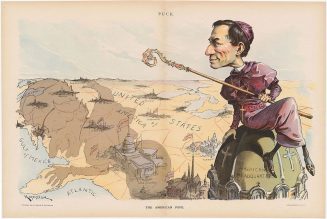
A dialect from the state’s earliest Spanish-speaking settlers has endured for over 400 years in the state’s remote mountain villages. But its time may be running out.
WHY WE’RE HERE
We’re exploring how America defines itself one place at a time. In a small village in northern New Mexico, some residents still speak the oldest Spanish dialect in the country.
April 9, 2023
QUESTA, N.M. — When the old regulars gather at Cynthia Rael-Vigil’s coffee shop in Questa, N.M., a village nestled in the snow-capped Sangre de Cristo Mountains, they sip lattes and lavender lemonade and gossip in Spanish.
Someone from Mexico City or Madrid sitting at the next table could be hard-pressed to follow their rare dialect. But Spanish speakers from four centuries ago might have recognized the unusual verb conjugations — if not the unorthodox pronunciations and words drawn from English and languages indigenous to North America.
For more than 400 years, these mountains have cradled a form of Spanish that today exists nowhere else on earth. Even after the absorption of their lands into the United States in the 19th century, generations of speakers somehow kept the dialect alive, through poetry and song and the everyday exchanges on the streets of Hispanic enclaves scattered throughout the region.
Even just a few decades ago, the New Mexican dialect remained at the forefront of Spanish-language media in the United States, featured on television programs like the nationally syndicated 1960s Val de la O variety show. Balladeers like Al Hurricane nurtured the dialect in their songs. But such fixtures, along with the dazzling array of Spanish-language newspapers that once flourished in northern New Mexico, have largely faded.
Spots like Ms. Rael-Vigil’s coffee shop, where the dialect’s melodic sounds can still occasionally be heard, are few and far between. In places like Albuquerque, New Mexico’s largest city, the dialect is being eclipsed by the Spanish of a new wave of migrants, particularly from the state of Chihuahua in northern Mexico.
At the same time, there are questions about whether the rural communities that nurtured New Mexican Spanish for centuries can themselves last much longer in the face of myriad economic, cultural and climate challenges.
“Our unique Spanish is at real risk of dying out,” said Ms. Rael-Vigil, 68, who traces her ancestry to a member of the 1598 expedition that claimed New Mexico as one of the Spanish Empire’s most remote domains. “Once a treasure like this is lost, I don’t think we realize, it’s lost forever.”
Those speaking New Mexican Spanish in Questa, a village of about 1,700 near the state line with Colorado, tend to be in their 50s or older. Even in her own family, Ms. Rael-Vigil sees the language slipping away; her 11-year-old grandson speaks almost no Spanish of any dialect.
“He has no interest,” she said. “Kids his age master the internet; that’s all in English. I sometimes wonder, did my generation not do our part to keep the language alive?”
I grew up in an old adobe home in Ribera, a village near the Pecos River, speaking some New Mexican Spanish — enough to get by, though not as splendidly as some classmates. Some of my earliest memories involve listening to my grandmother as she chatted in the dialect while flipping tortillas with her fingers on a wood stove.
Despite being born in New Mexico and spending nearly her entire life in the state, my grandmother spoke hardly any English. She is gone now, and with her and those of her generation, the region is losing a linguistic treasure trove harkening back centuries.
New Mexican Spanish is often described as a sampling of 17th century Golden Age Spanish imported directly from the Old World, and somehow meticulously safeguarded in isolation. That depiction may include kernels of truth, linguists say, but the origins and development of the dialect, which they consider an offshoot of the Spanish of northern Mexico, are far more nuanced and complex than the myth.
It is thought to have crystallized around the late 16th century, when a linguistically and ethnically mixed colonizing expedition put down stakes here as part of the European competition for the New World — years before the first permanent English settlement in North America was established in 1607 in Jamestown, Va.
The colonists included Europeans from Spain, Portugal and Greece, but also Mexican-born people of mixed Indigenous, European and African ancestry, as well as Indigenous people, thought to be Tlaxcalan Indians, who spoke Náhuatl, the lingua franca of the Aztec Empire.
The settlers relied on supply caravans known as conductas to maintain ties with Mexico City. But the small colony could be completely cut off from the outside world for stretches of several years, raising comparisons with places such as the Andean highlands or southern Chile, where the Spanish language evolved in similar isolation.
Damián Vergara Wilson, a scholar at the University of New Mexico who specializes in the state’s rare variety of Spanish, said he compares the settlement in what was then the northern fringes of the Spanish Empire to an off-world colony.
“What if we went to Mars on a space vessel and lost contact with other speakers?” Mr. Wilson said. “That’s what happened here. There was very minimal contact.”
While the dialect’s speakers can generally hold a conversation with someone from any of the countries where Spanish is the majority language, those still proficient in New Mexican Spanish can also sound considerably different. (Linguists often call the dialect Traditional New Mexican Spanish or the Spanish Dialect of the Upper Rio Grande Region, drawing a contrast with the more Mexican-influenced Spanish of southern New Mexico.)
In the places where it took root, in northern New Mexico and Southern Colorado, speakers use words like ratón volador (flying mouse) for bat instead of murciélago, as in standard Spanish, and gallina de la sierra (mountain chicken) for turkey instead of pavo or guajalote.
They incorporated Indigenous words like chimal (shield) from Náhuatl, chimayó (obsidian flake) from Tewa and cíbolo (buffalo) from Zuñi, as well as bisnes (business), crismes (Christmas), sanamagón (son of a gun) and many others from English.
Speakers conjugate creatively, employing unusual verb endings, and tend to aspirate the “s” sound in many words, making it similar to the “h” in English (or the “j” in Spanish). For instance, they might say “No je donde está la caja” (I don’t know where the house is) instead of the standard “No sé donde está la casa.”
Len Nils Beké, a linguist who completed his doctoral studies this year at the University of New Mexico, was previously at Ghent University in Belgium, known for its strong Spanish linguistics program, when he told colleagues about the dialect he had encountered in New Mexico.
“They seemed astonished at every turn,” said Mr. Beké, who traveled by bicycle between far-flung villages to conduct field research in New Mexican Spanish, often camping under the stars. “It was like, ‘Wow, they do this? Wow, they do that?’”
The dialect has managed to survive for the nearly two centuries since the United States took possession of New Mexico in 1848, making it the oldest continuously transmitted variety of Spanish in the country. Still, in an era when immigration from Latin America has boosted the number of hispanohablantes in the United States to more than 41 million, the fortunes of New Mexican Spanish — and the region where it once flourished — have been going in another direction.
Economic forces have fueled an exodus from the aging northern villages made up of crumbling adobe homes. Other threats — such as the largest wildfire in New Mexico’s recorded history, which tore through the state’s Hispanic heartland a year ago, and the worst megadrought since before the Spanish settled here — have revealed the fragility of these traditional outposts to extreme weather exacerbated by climate change.
Despite the hardships, there are still some in the region trying to provide the dialect a lifeline.
Julie Chacon, executive director of the Sangre de Cristo National Heritage Area, an organization in Alamosa, Colo., grew up speaking New Mexican Spanish in the nearby village of Capulín, where it had spread across the state line to Southern Colorado in the 19th century. She is now collecting oral histories from viejitos (old ones), assembling workbooks to teach the dialect, and running a heritage camp for children.
Daniel Lee Gallegos and his band Sangre Joven of Las Vegas, N.M., hold jam sessions on Facebook for the nuevomexicano diaspora, and Carlos Medina, a comedian and musician, revels in the dialect’s playful creativity.
“The language absolutely will survive,” said Larry Torres, a linguist who writes a bilingual column for The Taos News and Santa Fe New Mexican. “It may not be the same language that our ancestors recognized, but we’re using a form of 15th century Spanish with 21st century English.”
Others are not so sanguine about the dialect’s chances of survival, at least not in the form in which it has been recognizable for centuries.
Mark Waltermire, a linguistics professor at New Mexico State University, said he expected New Mexican Spanish to survive for at least two more decades, if only because there are people in their 50s who still speak it.
Beyond that time frame, however, he said it is hard to see a path forward for the dialect — which does not mean Spanish will disappear from New Mexico. “It’s just being replaced,” he said, citing the arrival of new immigrants from Mexico, “with a different kind of Spanish.”
![New Mexico Is Losing a Form of Spanish Spoken Nowhere Else on Earth [NYTimes Paywall]…](https://salvationprosperity.net/wp-content/uploads/2023/04/new-mexico-is-losing-a-form-of-spanish-spoken-nowhere-else-on-earth-nytimes-paywall-1050x600.jpg)







